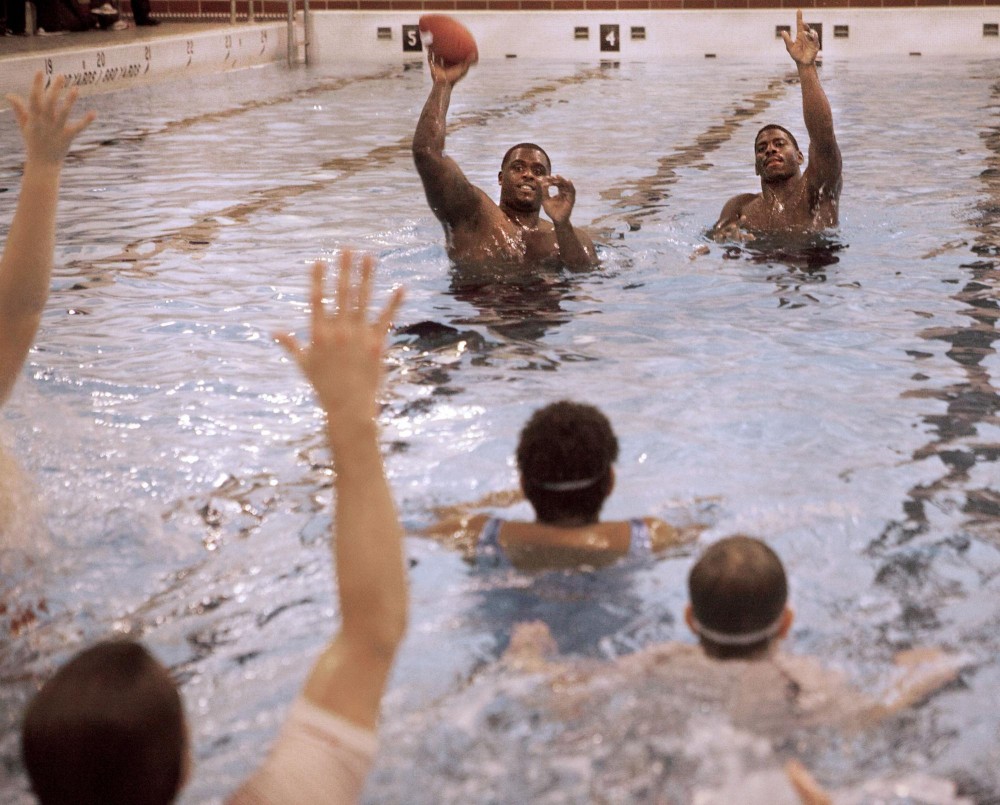Eight-year-old Mitchell LeumaâÄôs school friends didnâÄôt believe him when he said he was going swimming with the Minnesota Vikings. Five hours later he was relay-racing #90 defensive tackle Fred Evans.
Kids from the community who are in a weight management and physical fitness program called the âÄúVikingâÄôs Fitness PlaybookâÄù at the University of Minnesota had the opportunity to meet up with Minnesota Vikings players Tuesday at the Cooke Hall swimming pool.
Ten children ages 8-16 enrolled in the fitness program on a recommendation from their doctors because they are in the 95th to 99th weight percentile. By participating, their family gets a year-long membership at a Life Time Fitness center plus a 10-week âÄúimmersionâÄù experience at the University of Minnesota.
The three-year program, sponsored by the Vikings ChildrenâÄôs Fund, is also a platform for pediatric heart research.
Every Tuesday, families meet with program coordinators, a dietician and University students who are the kidsâÄô âÄúPALsâÄù âÄî Physical Activity Leaders.
In the spirit of the football season, the program is divided into âÄúoffenseâÄù and âÄúdefenseâÄù: physically active group activities and education and discussion about diet, respectively.
Mitchell hardly needs encouragement to be active. He plays soccer and does hockey year round âÄî thatâÄôs why it was frustrating when he kept gaining a couple pounds every month, said Jen Leuma, his mother.
Kinesiology senior Brian McMahon, MitchellâÄôs PAL, said the second grader recently told him heâÄôs started drinking more water. ItâÄôs a good step, McMahon said, because it decreases appetite.
âÄúI hope the things he learns, especially the diet aspects, he remembers when heâÄôs 18 or 19,âÄù McMahon said.
Jen Leuma has been trying to cook healthier meals for her whole family. She knew it was having an effect when Mitchell uncharacteristically ate up burgers made with turkey and black beans instead of ground beef.
Research shows that when parents model the physical activity by doing it with their children, it helps kids modify their behavior and sustain the weight loss they achieve, said Dr. Aaron Kelly, co-investigator on the project.
âÄúThe whole family needs to buy in and do it,âÄù Kelly said.
Twenty percent of children in the U.S. ages 6-19 weigh above the 95th percentile for body mass index, according to the 2008 National Health and Nutrition Examination Survey.
One of the University programâÄôs goals is to prevent the kids from relapsing into unhealthy lifestyle choices by helping them form reasonable, sustainable eating and exercise habits.
âÄúItâÄôs not realistic to say you canâÄôt have candy on Halloween,âÄù Kelly said. âÄúJust donâÄôt eat the whole bucket.âÄù
The programâÄôs registered dietician Jana Dengel teaches kids the trade-offs for their choices. If a second grader wants to drink a 300-calorie soda, he or she has to walk six miles to burn the energy, for example, she said.
âÄúWhen you get kids thinking about that, they see food in a different way,âÄù Dengel said.
For the dozen kinesiology students that get to be part of the Vikings Fitness Playbook study, itâÄôs also an unusual opportunity to apply their coursework to real familiesâÄô challenges.
A barrier that kinesiology senior Becca Gusmer helped her pal overcome was the problem of not having time to eat breakfast while rushing to the bus. Hearing the childâÄôs eventual solution âÄî a portable cup of cereal âÄî was rewarding for Gusmer.
The Vikings ChildrenâÄôs Fund has worked closely with the UniversityâÄôs Department of Pediatrics for many years. The money is often used to fund seedling research, but in recent years the focus has expanded to more visible community outreach.
Vikings players that take interests in certain medical areas have taken initiative to help out the University over the years, said Joe Neglia, head of the Pediatrics Department. Vikings guard #76 Steve Hutchinson and his wife held dinners for hospitalized families, for example. Brett Favre donated $200,000 to a program that outfits rooms at Amplatz ChildrenâÄôs Hospital with special technology.








